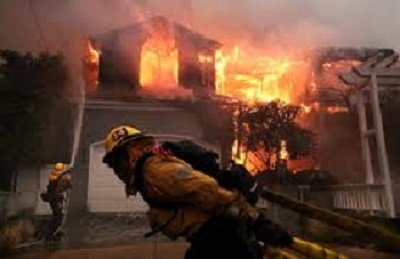The Palisades Fire, a significant wildfire event, underscores the growing challenges of managing fire-prone areas in California and other parts of the world. This article explores the origins, impact, response, and lessons learned from the fire, highlighting its implications for community resilience and wildfire management. The fire, located near Pacific Palisades, has drawn attention to the increasing frequency of wildfires in the region.
Origins of the Palisades Fire
The Palisades Fire ignited in the rugged terrain of the Santa Monica Mountains, an area characterized by steep canyons, dense vegetation, and a Mediterranean climate. Investigations revealed that the fire was human-caused, with suspicions ranging from negligence to intentional arson. The challenging topography and accumulation of dry brush created a perfect storm for rapid fire spread once the blaze began. Maps of the Palisades Fire highlighted its proximity to densely populated areas, raising concerns among residents.
Conditions Fueling the Blaze
Southern California’s weather patterns, including prolonged droughts, high temperatures, and the infamous Santa Ana winds, created ideal conditions for the fire to grow uncontrollably. The region had experienced a lack of significant rainfall, leaving vegetation parched and highly flammable. Additionally, climate change has exacerbated these conditions, leading to more frequent and intense wildfires across Los Angeles and beyond.
Fire Behavior and Spread
The Palisades Fire quickly spread over thousands of acres, threatening homes, wildlife habitats, and recreational areas. Its unpredictable behavior, fueled by erratic winds and steep terrain, made it difficult for firefighting crews to establish control lines. Spot fires ignited ahead of the main blaze, increasing the complexity of suppression efforts. The fire’s progression was tracked using live fire maps, aiding emergency response teams.
Community Impact
Displacement and Evacuations
Hundreds of residents in the Pacific Palisades and Topanga areas faced mandatory evacuation orders. The sudden nature of the fire forced families to leave their homes with little notice, causing emotional distress and logistical challenges. Emergency shelters provided temporary relief, but the uncertainty about the fate of their homes weighed heavily on evacuees. Areas such as Palisades Charter High School were designated as evacuation centers.
Property Damage
While firefighters managed to save many structures, some homes and properties were destroyed or severely damaged. The fire’s path highlighted vulnerabilities in urban-wildland interfaces, where development meets natural landscapes. Reports of damage near the Getty Villa and Pacific Palisades further underscored the fire’s reach.
Environmental Consequences
The Palisades Fire caused significant environmental damage, including the destruction of native flora and fauna. Wildlife habitats were disrupted, forcing animals to flee or perish in the blaze. The fire also left behind charred landscapes prone to erosion and mudslides, particularly during subsequent rainy seasons. Recovery efforts in areas like Eaton Canyon focused on stabilizing ecosystems.
Firefighting Efforts
Resources Deployed
Hundreds of firefighters, supported by aerial tankers and helicopters, battled the Palisades Fire. The steep terrain posed challenges for ground crews, necessitating extensive use of air resources to drop water and fire retardant. Fire maps of Los Angeles were continuously updated to coordinate efforts effectively.
Collaboration and Coordination
The firefighting response involved multiple agencies, including the Los Angeles Fire Department (LAFD), California Department of Forestry and Fire Protection (Cal Fire), and local law enforcement. Coordinated efforts ensured efficient resource allocation and communication, helping to contain the fire more effectively. Maps highlighting evacuation zones and fire progression played a crucial role in these operations.
Challenges Faced
Firefighters faced several challenges, including limited access to remote areas, rapidly shifting winds, and extreme heat. Despite these obstacles, their tireless efforts minimized the fire’s impact on densely populated areas such as Pacific Palisades and nearby communities.
Recovery and Rebuilding
Community Support
In the aftermath of the Palisades Fire, community members rallied to support affected families. Fundraisers, donation drives, and volunteer efforts provided financial and emotional assistance to those in need. Local governments also worked to streamline recovery processes, including permitting for rebuilding and debris removal. Areas like Altadena and Santa Monica, also affected by wildfires, offered insights into effective recovery strategies.
Environmental Restoration
Efforts to restore damaged ecosystems began shortly after the fire was contained. Replanting native vegetation, controlling invasive species, and stabilizing slopes were key priorities to prevent further environmental degradation. Agencies collaborated with conservation groups to implement long-term recovery plans in fire-affected zones, including Pacific Palisades and Eaton Canyon.
Lessons Learned
Enhancing Preparedness
The Palisades Fire underscored the importance of preparedness at both individual and community levels. Residents were encouraged to create defensible space around their properties, develop evacuation plans, and stay informed about fire risks. Tools like real-time fire maps and apps tracking California fires were recommended to improve situational awareness.
Advancing Fire Management Strategies
Authorities recognized the need for improved wildfire management strategies, including better use of technology for early detection, predictive modeling, and resource deployment. Investments in infrastructure, such as firebreaks and water storage facilities, were also deemed essential. The effectiveness of measures implemented during the Sylmar Fire and other Southern California fires provided valuable insights.
Addressing Climate Change
The role of climate change in exacerbating wildfire risks cannot be ignored. Policymakers and scientists called for more aggressive action to mitigate climate change impacts, including reducing greenhouse gas emissions and adopting sustainable land-use practices. California’s efforts to combat wildfires, such as those seen in Altadena and Pasadena, emphasized the importance of long-term strategies.
Conclusion
The Palisades Fire serves as a stark reminder of the growing threat posed by wildfires in an era of climate change. It highlights the need for proactive measures to protect communities, ecosystems, and infrastructure. By learning from this event and implementing more robust strategies, we can build resilience against future wildfires and safeguard the natural beauty of fire-prone regions. Maps of fires across California, including the Palisades Fire, have become critical tools in understanding and mitigating the impact of these disasters.
